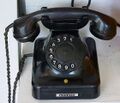Template:Selected anniversaries/February 14: Difference between revisions
No edit summary |
No edit summary |
||
| Line 52: | Line 52: | ||
||1899 – Voting machines are approved by the U.S. Congress for use in federal elections. | ||1899 – Voting machines are approved by the U.S. Congress for use in federal elections. | ||
||1904: Engineer and inventor [[Charles William Oatley (nonfiction)|Charles William Oatley]] born. He will develop of one of the first commercial scanning electron microscopes. | |||
||1911 – Willem Johan Kolff, Dutch physician and inventor (d. 2009) | ||1911 – Willem Johan Kolff, Dutch physician and inventor (d. 2009) | ||
Revision as of 10:06, 11 February 2018
1855: Texas is linked by telegraph to the rest of the United States, with the completion of a connection between New Orleans and Marshall, Texas.
1876: Alexander Graham Bell applies for a patent for the telephone, as does Elisha Gray.
1943: Mathematician David Hilbert dies. He discovered and developed a broad range of fundamental ideas in many areas, including invariant theory and the axiomatization of geometry.
1944: Physicist and academic Owen Willans Richardson publishes new theory of thermionic emission with applications in the detection and prevention of crimes against physics.
1949: ENIAC programmed to select optimal Valentine's Day gift.
1950: Physicist and engineer Karl Guthe Jansky dies. He was one of the founding figures of radio astronomy.
1951: Theoretical physicist and crime-fighter Richard Feynman uses principles of quantum electrodynamics to compose state-of-the-art Valentine's Day cards.
1990: The Voyager 1 spacecraft takes the photograph of planet Earth later become famous as Pale Blue Dot.
2009: Record attendance for Valentine's Day performance by Rhizolith Group.








